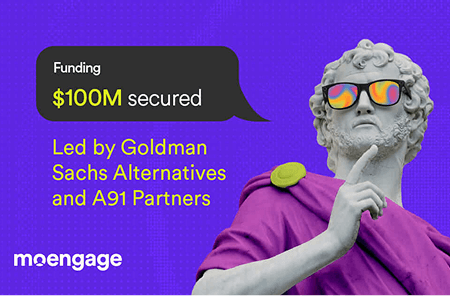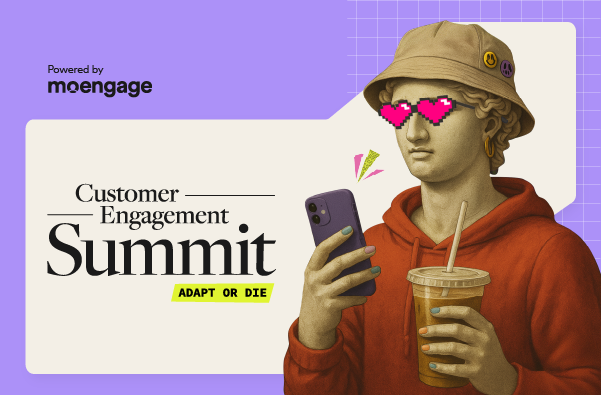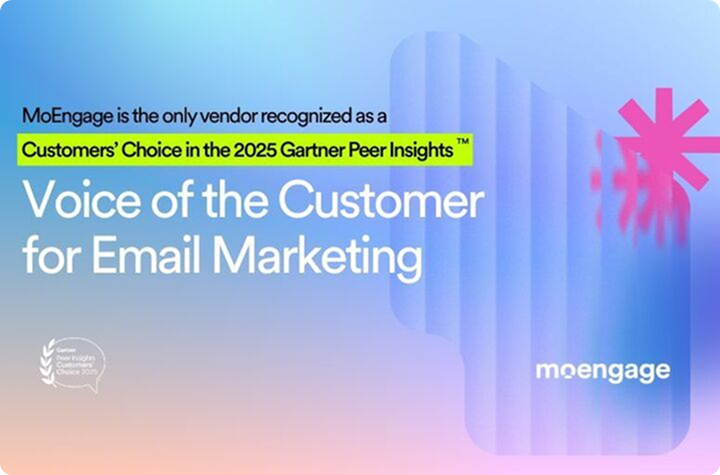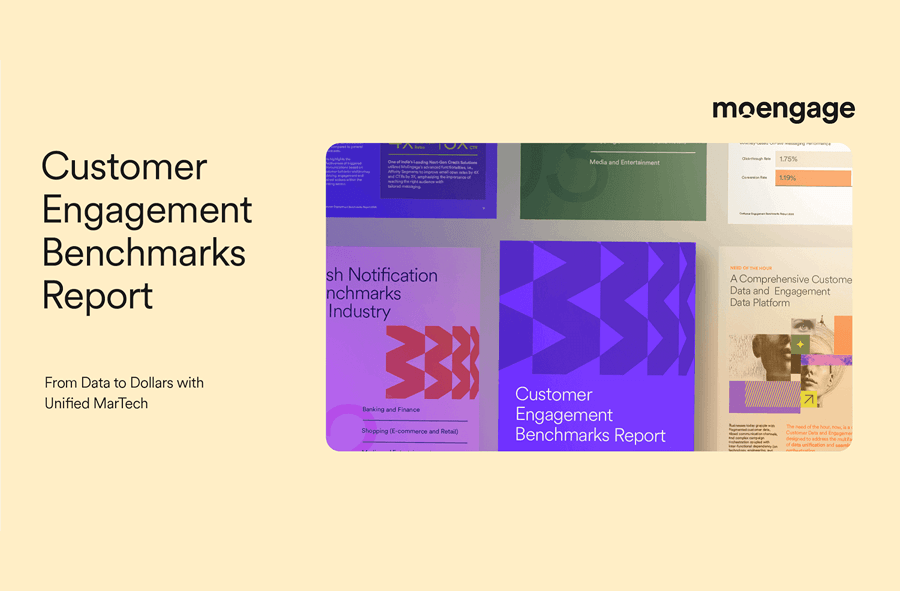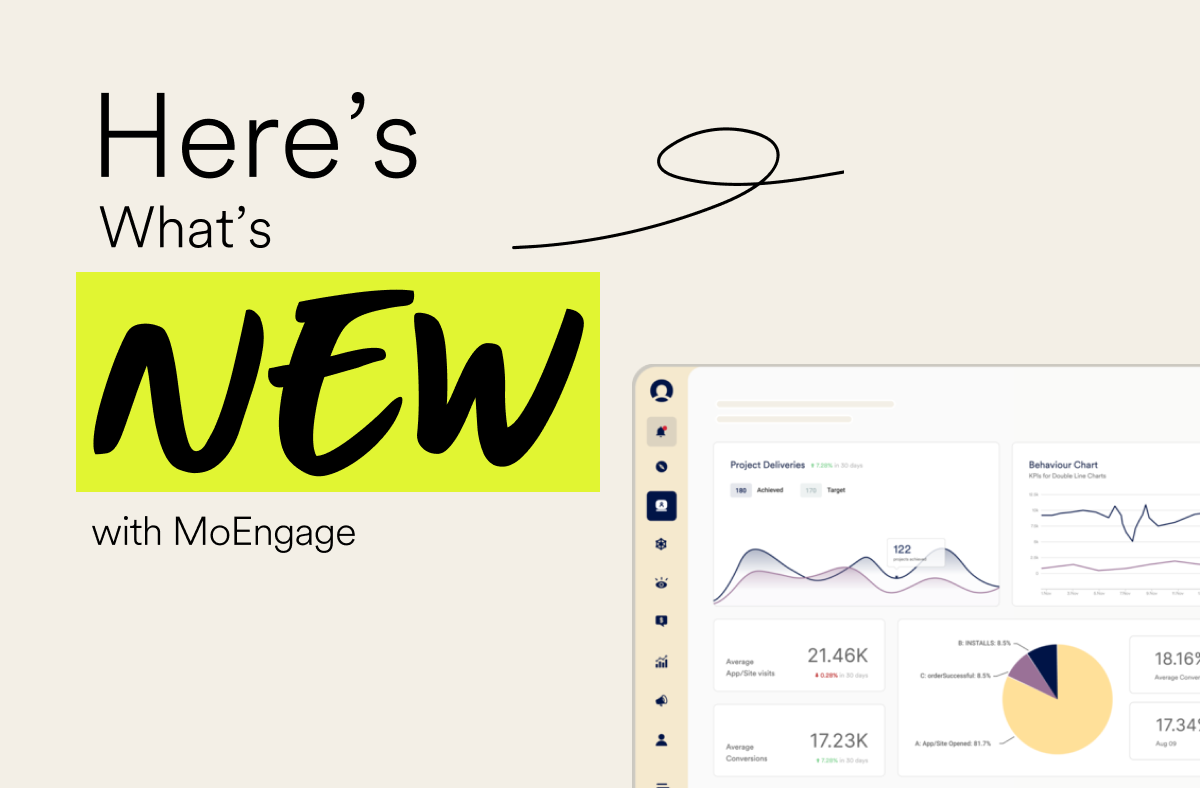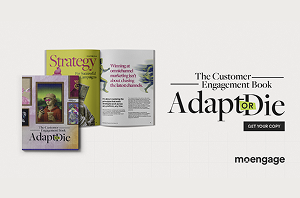Top 9 Adobe Marketo Engage Alternatives to Engage Customers

Reading Time: 17 minutes
Thinking about switching to one of the Adobe Marketing Cloud alternatives?
Maybe you’ve been using Adobe Marketo Engage for marketing automation or Adobe Journey Optimizer for customer journey orchestration. Or you’ve heard of its steep learning curves, sluggish performance during peak usage times, or its substantially high licensing costs.
And you wonder if there’s something faster, more flexible, and easier to run.
If any of this sounds familiar, you’re not alone. More and more B2C marketers are exploring alternative customer engagement platforms (CEPs) built for today.
That’s why we’ve put together this guide to the best Adobe Marketing Cloud competitors. This will help you choose the option that best fits your team and your needs. Let’s get started.
| Note
Here’s a breakdown of Adobe’s products to avoid any confusion:
|
9 Best Adobe Marketo Engage Alternatives for Customer Engagement
If you’ve considered Adobe as a customer engagement vendor before, you must’ve weighed Marketo Engage pros and cons before taking a decision. Time to do the same now.
You’ll find Adobe Marketing Cloud competitors in this list of customer engagement tools that solve all the challenges that typically come with legacy platforms like Adobe.
While some of these modern platforms unlock more channels that Adobe supports, others are designed to be more flexible and agile than Adobe.
1. Best for AI-driven omnichannel engagement: MoEngage
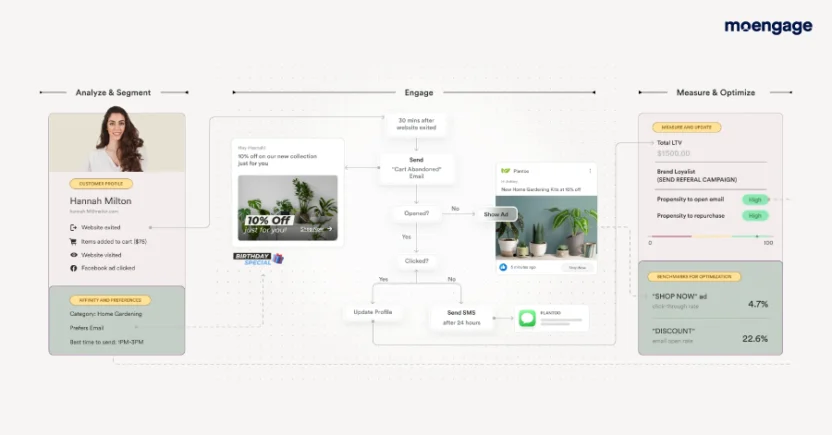
The reason why MoEngage’s customer engagement platform is one of the strongest Adobe Marketing Cloud alternatives is because of the sheer number of channels it supports. We’re talking engagement across every channel your customers actually use — that’s more than 10 — from a single dashboard.
Its Merlin AI adjusts campaigns fast by analyzing patterns and predicting the best way forward for every segment. As for robust analytics, you’ll find channel performance dashboards, campaign stats, and even custom dashboards to let you monitor any metrics you need.

Furthermore, Adobe Marketo Engage licensing is pretty expensive due to its lack of single-platform unification and the cost of its add-ons. In comparison, most brands find that the total cost of ownership for MoEngage is 25-35% lower than that of Marketing Cloud, and it speeds up time to market by 30% on average.
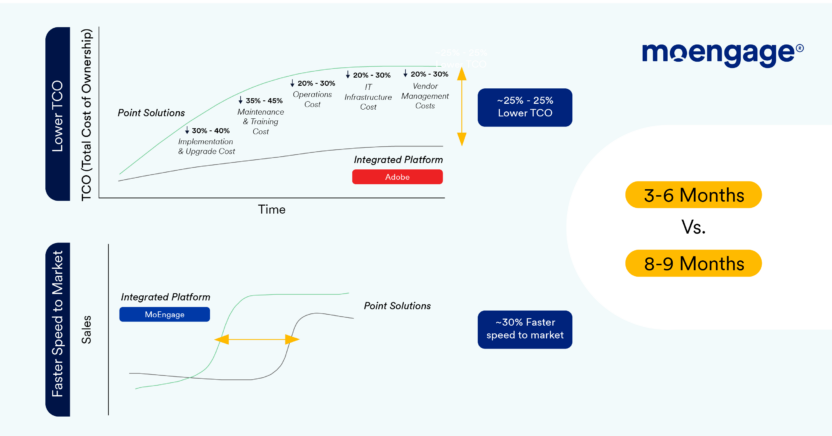
Cost: MoEngage is free for up to 10K Monthly Tracked Users (MTUs), and offers two pricing plans — Growth and Enterprise.
G2 Rating: 4.5/5
Channels: SMS, RCS, email, mobile and web push, WhatsApp, in-app and on-site messages, web personalization, Google Ads Audience, and Facebook Audience.
Standout Feature: AI Campaign Decisioning agent that clearly defines your campaign objectives and operational restrictions (like budgets) to deliver hyper-personalized experiences to every customer.
Why It’s Best for AI-driven Omnichannel Engagement: MoEngage unifies all channels your customers care about, and then personalizes their experiences from end to end.
What MoEngage Has That Adobe Marketo Engage Doesn’t:
We sourced all of this information directly from Adobe Marketo Engage’s website, with references, and it is accurate as of November 2025:
A) On-site messaging
Adobe Marketo Engage and Adobe Journey Optimizer together offer native support for email, push notifications, web personalization, WhatsApp, and in-app messaging. But Adobe doesn’t support on-site messaging.
MoEngage bakes the channel right into the campaign automation workflow. You can trigger personalized banners and pop-ups exactly when a customer is browsing your website. No third-party tools, no workarounds.
With MoEngage’s on-site messages, it’s easy to show a discount after someone scrolls, say, 30% down your product page. Or offer a nudge to a customer to complete their checkout after they leave items in their cart.
B) Most Preferred Channel
Adobe Journey Optimizer’s Send Time Optimization works only for email and push notifications. And that too, only inside specific journeys, not for all workflows. So, it doesn’t work if you’re sending messages through standalone campaigns or custom actions. Rules and rules.
MoEngage takes a broader approach with its Best Time to Send (BTS) feature. It works natively for email, push, and SMS campaigns, both one-time and periodic.
But instead of stopping at “What’s the best time to send messages?”, its Most Preferred Channel (MPC) capability first determines which channel each customer is most responsive to, whether email, push, or SMS. The algorithm doesn’t just look at frequency (how often they interact) but also the depth (whether they open, click, or ignore), calculating at a user level and updating the data automatically.
As a result, someone who usually interacts with SMS messages will get an SMS, while someone who consistently taps push notifications will get a push. And if a customer’s habits change, the data updates automatically.
C) PII Tokenized Sending
Adobe Journey Optimizer masks customer data in messages, while Adobe Experience Cloud encrypts data in transit and at rest. Both of these features help ensure customer data privacy and security, for sure.
But you know what adds an extra layer of security? PII Tokenized Sending.
Does Adobe offer it? No.
Does MoEngage? Yes.
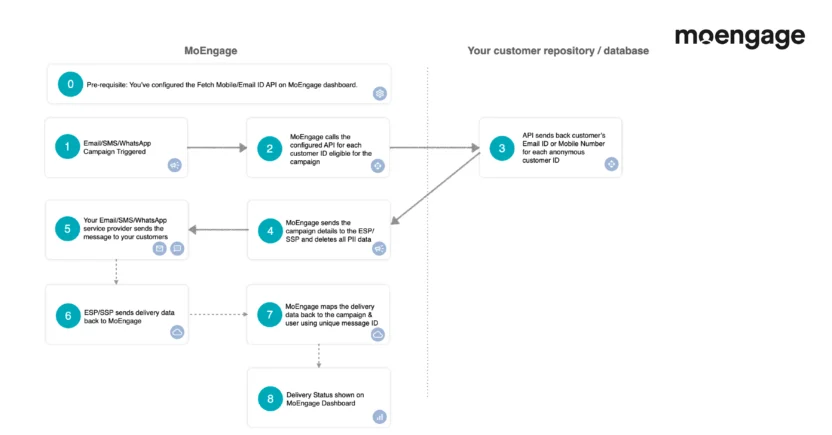
Apart from PII masking and data encryption, MoEngage’s PII Tokenized Sending ensures you can send campaigns without storing sensitive data inside MoEngage’s platform. How come?
Well, the data is translated into anonymous tokens. You can fetch that data in real-time only while sending your campaigns.
Overall, MoEngage is a great choice for enterprise brands seeking a customer engagement platform that can scale with their evolving needs and audience.

2. Best for building customer journeys: Ortto

A full-stack marketing automation and data analytics platform, Ortto lets you easily send growth-oriented campaigns. Its Customer Data Platform (CDP) gives you complete and instant access to real-time data and event-based analytics to gain insights into customer behavior.
However, multi-touch attribution, deeper customer segmentation, and other advanced features have limited capabilities compared to enterprise customer engagement platforms. Plus, you can’t dig into specific metrics on the reporting dashboards without extra manual work. Ortto also poses a steep learning curve when it comes to setting up complex marketing automation campaigns. Custom reports are limited, too.
Cost: Ortto’s pricing plans start at 5K or 10K contacts, with monthly, quarterly, and annual billing cycles. It offers four pricing tiers, ranging from $199/mo billed monthly for 5K contacts to $999/mo for 10K contacts. The first two plans don’t come with support for mobile push notifications, transactional messages, custom IPs, or professional onboarding, though. For priority support, dedicated email IPs, and Service Level Agreements (SLAs), Ortto has an Enterprise plan with custom pricing.
G2 Rating: 4.4/5
Channels: Email, SMS, mobile and web push notifications, and in-app messages.
Standout Feature: Open rate optimization to automatically resend unread emails with new subject lines.
Why It’s Best for Building Customer Journeys: Creating customer journeys in Ortto using its drag-and-drop visual journey builder is fairly easy. Because of different shapes signifying different channels and actions, it gets pretty simple to present or explain these journeys to your team and stakeholders.
3. Best for lead scoring: Act-On

Act-On is another of the Adobe Marketing Cloud alternatives because it makes customer data actionable. It’s a marketing automation platform that helps you optimize all the stages in the customer journey, from awareness to advocacy, through its customer marketing features. As a result, you can easily convert visitors into prospects, then qualified leads, and finally into lifetime customers.
The downside is that new Act-On users may find the user interface difficult to navigate. The reporting dashboard is also not flexible enough to be customized for more complex situations.
Cost: Thankfully, Act-On charges just for active contacts, and not your entire database. Starting with 2,500 active contacts per month, you’ll pay $900/ mo for the same. 10K monthly active contacts would cost you $1,375/ mo. But regardless of the number of active contacts, if you need access to Data Studio for advanced reporting and CRM integration with Salesforce and other apps, Act-On offers custom pricing.
G2 Rating: 4.1/5
Channels: Email, SMS, and social media.
Standout Feature: Automated lead generation to convert cold prospects into closed deals through forms, landing pages, and personalization.
Why It’s Best for Lead Scoring: You can easily develop lead scoring frameworks with unique parameters to send more qualified leads to sales. Act-On also lets you create multiple scoring sheets for different audience segments.
4. Best for sales and marketing integration: HubSpot Marketing Hub
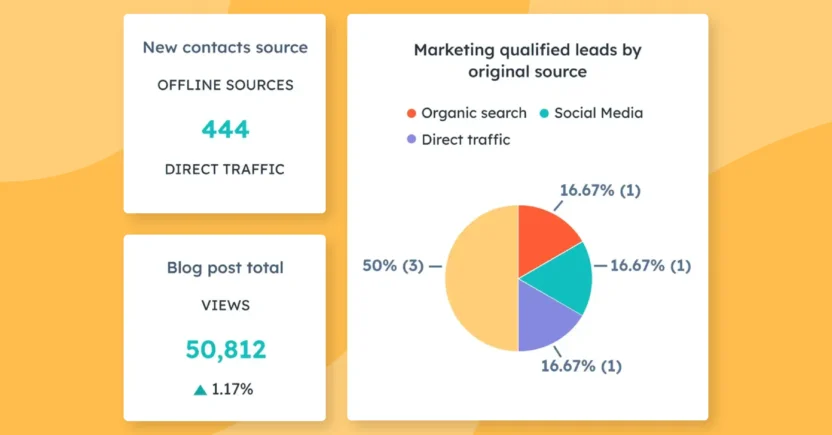
Without tight alignment between your marketing and sales teams, your brand can’t function efficiently. That’s why HubSpot Marketing Hub exists, centralizing customer data for better marketing automation.
On the other hand, running multiple databases in one platform can start feeling cluttered. Flagging the steep learning curve for new users, smaller teams report needing more onboarding support to get the most out of the system.
Cost: For 2K contacts, 5K campaigns, and 3 users per account, pricing begins at $890/ mo. You need to pay $3K as a one-time onboarding fee. If you have an enterprise team, HubSpot Marketing Hub will cost you $3.6K/ mo for 5 users and 10K contacts. Under this plan, the onboarding fee increases to $7K.
G2 Rating: 4.5/5
Channels: Email, social media, and SMS (plus push through OneSignal, and separate WhatsApp integration).
Standout Feature: Lookalike Lists to target similar high-intent prospects.
Why It’s Best for Sales and Marketing Integration: HubSpot Marketing Hub sits within the HubSpot CRM, allowing you to keep all your customer data centralized and clearly prove the ROI on campaigns.
5. Best for customer data management: Salesforce Marketing Cloud
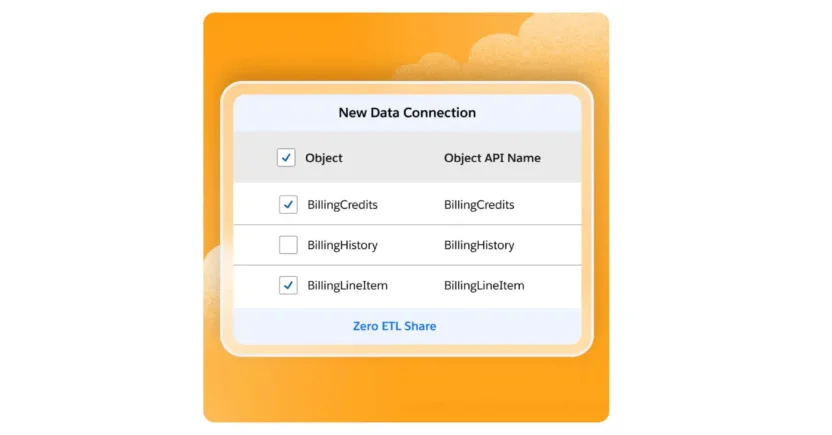
If managing lots of customer data across multiple systems gives you headaches, Salesforce Marketing Cloud (now known as ‘Agentforce Marketing’) would be an appealing option. That’s why it’s one of the best Adobe Marketing Cloud alternatives. Its deep integration with Salesforce CRM means that you can sync everything, from purchase history to behavioral data, to create unified customer profiles.
But you know what? You can’t deny the steep learning curve. Each module often requires certification just to start using it effectively. Add in the challenges of any legacy system — rigidity, pricey maintenance, incompatibility with modern apps — and your marketing campaigns aren’t agile anymore.
Cost: Salesforce’s monthly Starter plan begins at $25 per user. For access to multi-channel journeys and landing pages, the Growth edition is available for $1.5K per month. If you need path experimentation and AI scoring, you can upgrade to the Advanced Plan for $3.25K per month.
G2 Rating: 4/5
Channels: Email, mobile push, social media, SMS, WhatsApp, and ads
Standout Feature: Path Experimentation to let you test different customer journeys, so you can understand how exactly customers engage with your campaigns.
Why It’s Best for Customer Data Management: With two-way data flows connecting Salesforce to Snowflake, BigQuery, and other partners, you can combine inventory stats, click data, or even third-party information to personalize communication at scale.
6. Best for data redaction: Oracle Responsys

Oracle Responsys can be considered one of the Adobe Marketo Engage alternatives in that it’s a legacy platform, too. It helps you manage your digital relationships and deliver the right messages to the right customers on the right channels.
However, its performance occasionally lags when you need to generate effective results. The platform is expensive as well, and too complex to implement and maintain, especially for new users. So, there’s no reason why you shouldn’t look out for alternatives to Oracle Responsys, too, in case you’ve got it on your radar.
Cost: Responsys’ pricing is a bit overwhelming. All initial Oracle Responsys deals include a minimum 12-month lock-in period. You also need to purchase consulting services, either from a Specialized Partner or from Oracle Marketing Cloud (OMC) GSU Services. The one-time Behavioral Data Restore Cloud Service fee is $5K, while transactional messaging costs $250 per month.
G2 Rating: 3.9/5
Channels: Email, SMS/MMS, push notifications, and in-app messages.
Standout Feature: Subject Line Predictions for Email to boost email open rates.
Why It’s Best for Data Redaction: Responsys protects customer data by masking or redacting customers’ Personally Identifiable Information (PII) from the platform’s end users.
7. Best for audience segmentation: Iterable
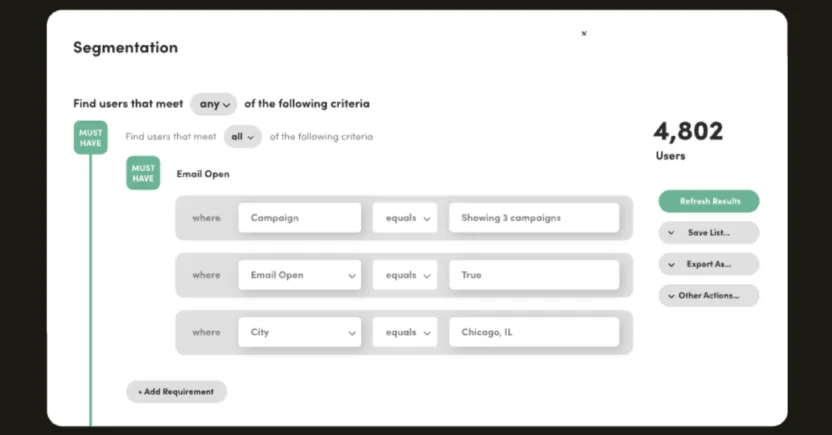
Among Adobe Marketing Cloud alternatives, Iterable is an excellent choice if you need fast, flexible audience segmentation. As an email-first customer communication platform, it’s got pretty intuitive navigation.
The downside of Iterable is that its email templates aren’t flexible enough. There’s also no way to fully customize analytics reports. In addition, you can occasionally experience performance lag when managing complex automations.
So, there’s no harm in exploring the best alternatives to Iterable, while you’re at it.
Cost: Iterable for every contact in your database, even unsubscribed and inactive ones. It also charges add-on fees for basic channels like mobile and web push notifications.
G2 Rating: 4.4/5
Channels: SMS, Roku, email, push notifications, in-app and on-site or in-browser messaging, and WhatsApp.
Standout Feature: Iterable Nova, which helps you personalize messages and fine-tune your campaigns with minimal manual work.
Why It’s Best for Audience Segmentation: You can segment customers based on their lifecycle stage, real-time behavior, or campaign interaction. Iterable also allows you to use Recency, Frequency, and Monetary Value (RFM) segmentation.
8. Best for flexible navigation: Braze
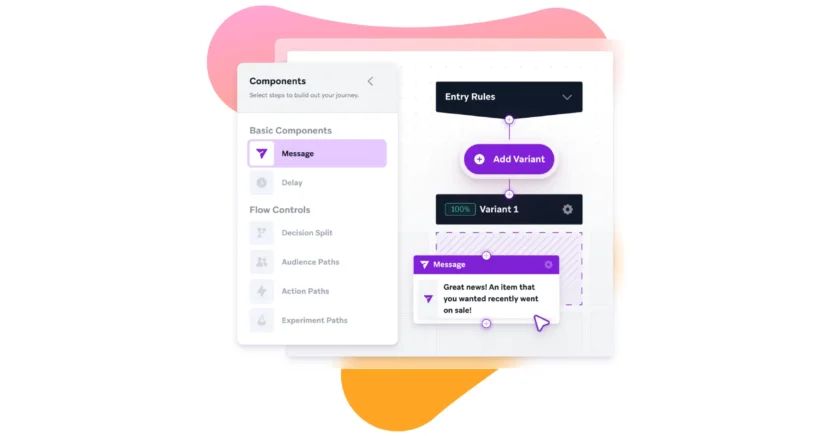
Braze combines strong first-party data unification with real-time segmentation and journey orchestration. Unlike some of the Adobe Marketing Cloud competitors on this list, Braze is refreshingly straightforward to navigate, thanks to drag-and-drop components and structured onboarding guides.
On the flip side, integration with existing systems can be tricky sometimes. The initial setup phase can also be complex, unless you have technical support on hand. Keep a lookout for alternatives to Braze, just in case.
Cost: Braze’s Enterprise plan follows a custom pricing model, including advanced capabilities, dedicated support, and broader integrations.
G2 Rating: 4.5/5
Channels: SMS, RCS, email, LINE, mobile app, WhatsApp, and web.
Standout Feature: BrazeAI™ to experiment and automatically optimize the best customer engagement strategies.
Why It’s Best for Flexible Navigation: Braze’s elegant and user-friendly interface, coupled with detailed documentation, makes it one of the easiest platforms to navigate.
9. Best for email templates: Insider
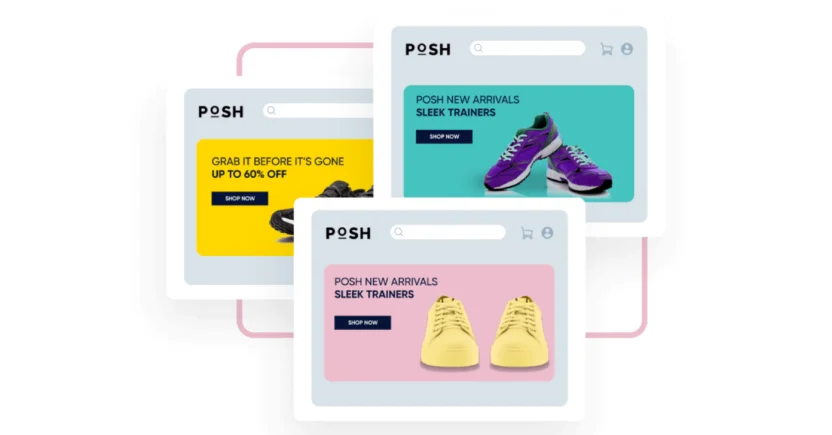
Insider aggregates your customer data and automatically builds 360-degree profiles based on purchase history, engagement data, lifecycle stage, and more. From there, it builds segments using campaign history, channel preferences, and Customer Lifetime Value (LTV) scores.
However, some users wish Insider’s analytics were more intuitive and its reporting more robust. Like many of the Adobe Marketo Engage competitors on this list, there’s a learning curve if you’re new to advanced marketing automation.
Cost: Insider charges $500 a month for basic features, and $1.5K a month for more advanced ones.
G2 Rating: 4.8/5
Channels: SMS, web and app push, email, WhatsApp, web personalization, and social ads.
Standout Feature: Smart Recommender that suggests trending products or frequently bought-together items to increase Average Order Value (AOV).
Why It’s Best for Email Templates: With a drag-and-drop editor and ready-to-go email templates, email campaigns can be up and running in hours, not days.
4 Key Criteria to Consider When Choosing an Adobe Marketing Cloud Competitor
Switching customer engagement platforms is a big move. Nobody wants to deal with another migration just a year or two down the line.
Here’s the lens to look through, before you decide on one of the top Adobe Marketo Engage alternatives.

1. Do the Adobe Marketing Cloud alternatives match your brand and industry?
See if your new customer engagement platform works for your customers, your goals, your product cycles, and your channels. For example, the goals and needs of a subscription app’s churn prevention campaigns would be different from those of a retail loyalty program’s automation campaigns.
Questions to ask yourself about this when looking for an Adobe Marketo Engage alternative:
- Does the platform support the channels your customers use the most?
- Can it handle the message types, data flows, and triggers that matter in your industry?
- Has the vendor seen great results with brands like yours?
- Can you access their clients’ success stories?
2. Is the Adobe Marketing Cloud alternative flexible enough to change?
Look for an Adobe Marketo Engage competitor that grows with your brand and adapts when strategies shift. You don’t want to migrate from one legacy platform to another, where agility would be like reaching for the moon.
Questions to ask yourself about this when looking for an Adobe Marketing Cloud alternative:
- Can you double your audience size without prices exploding?
- Will the new platform let you add and test more channels fast?
- How fast can it adapt to data privacy laws or new compliance regulations, such as the new Telephone Consumer Protection Act (TCPA) rules?
3. Is it easy to use and automate?
If you can automate a repetitive task, you should. Period. But if you have to call in a developer every time you need a tweak or to set up a trigger for marketing automation, you’re in trouble.
Questions to ask yourself about this when looking for an Adobe Marketing Cloud alternative:
- How easy is it to build cross-channel automated customer journeys on the new platform without dev support?
- Can you reuse and copy workflows across campaigns?
- Can you combine automation with AI-driven targeting (like the best time to send emails)?
- Will your team be self-sufficient, or will you need to rely on IT support all the time?
4. How fast can the vendor migrate and onboard your data?
Suppose you’ve found an Adobe Marketing Cloud competitor that can send campaigns lightning-fast. But it takes 6 months to go live. Would you still go ahead with that platform?
We thought not. Nor would you be happy with a legacy system that buries the migration process in endless bureaucracy.
Questions to ask yourself about this when looking for an Adobe Marketo Engage alternative:
- What’s the vendor’s fastest migration timeline been?
- How will your data get migrated (API or CSV), and who will manage what?
- Will they provide you with full technical documentation for SDKs and APIs?
- Can your team realistically stay on top of the migration tasks without stalling other work?
Top 3 Adobe Marketo Engage Alternatives Feature Comparison
Picking the right option from among the alternatives to Adobe Marketing Cloud is easier said than done, especially when evaluating enterprise customer engagement platforms. That’s why we’ve prepared a feature-by-feature comparison for you. So now, it’s simpler for you to see which platforms actually deliver the channels and features you need.
Below, we’ve compared three of the top Adobe Marketo Engage competitors across the criteria that matter most when modernizing customer engagement – MoEngage, Ortto, and Act-On.

Source: https://www.g2.com/compare/adobe-marketo-engage-vs-moengage-vs-ortto-vs-act-on?source=search
Now, let’s compare these top Adobe Marketing competitors side-by-side in terms of the key features that matter most to marketers at modern B2C brands.
| Criteria | Adobe Marketo Engage | MoEngage | Ortto | Act-On |
| G2 Rating | 4.1/5 | 4.5/5 | 4.4/5 | 4.1/5 |
| Channels Supported | Email, push notifications, web personalization & in-app messaging | SMS, RCS, email, mobile & web push, WhatsApp, in-app & on-site messages, web personalization, Google Ads Audience & Facebook Audience | Email, SMS, mobile & web push notifications, and in-app messages | Email, SMS & social media |
| Send Time Optimization | Only for email & push in specific journeys | Available for any email, push & SMS campaign | Not available | Not available |
| Most Preferred Channel | Not available | Matches customers to the best channel & updates automatically per changing preferences | Not available | Not available |
| PII Tokenized Sending | Not available; only PII masking & data encryption available | Available | Not available; only data encryption available | Not available |
5 Migration Strategies When Switching To an Adobe Experience Cloud Competitor
When moving from a legacy platform like Adobe, migrations can be a long process. The timelines are often unclear, and teams can feel disconnected, as if they are outsiders in their own projects.
But following a customer engagement platform migration strategy leaves no room for floundering. Here’s how to map a realistic migration plan and avoid the delays that typically occur with old-school systems.
1. Map out every stage in the migration process
Before diving headfirst into the migration process, break down all the stages and everything you’ll need to move forward, from user attributes and properties to content templates and historical campaign data. Also, think about how you’ll move them to the Adobe Marketo Engage competitor, whether through CSV imports or using APIs.
Work with the new vendor to map out a stage-by-stage plan. Set realistic timelines for each stage, based on similar migrations the new vendor has run before.
2. Build the right migration squad
Rope in your product, marketing, data management, and IT teams into the migration process from Day One. This ensures every department’s needs are baked into the process. Ask all the stakeholders to share their requirements, and assign a single project manager to keep the plan on track.
You’ll be looking at a process that can span weeks, so only a kick-off meeting won’t work. What you need are regular check-ins, so there are zero siloed decisions. The more looped in everyone on your team is, the more their needs can be met.
Just like SoundCloud ensured all its stakeholders were roped in while migrating over 200 SoundCloud campaigns to MoEngage in 12 weeks. The result? A 15% uplift in engagement in music streams on SoundCloud.
3. Document all the steps in the migration process
A migration from legacy systems like Adobe Marketo Engage means more hassles than you’d face while migrating from a modern customer engagement platform. That just takes up more time than expected. And the last thing you want is to be slowed down just because of a poorly-documented migration.
Treat documentation as a part of your migration plan, and not an afterthought. Ask the team of the Adobe Marketing Cloud alternative to supply you with up-to-date API and SDK documents.
Once you get them, review them so you’re not struggling during setup. Keep your own migration notes precise, so that anyone else from your team can keep the momentum going when you’re not around. And whenever you expand, integrate another data stream, or migrate again (let’s hope not), the documentation can come in handy.
4. Don’t wait for testing
Waiting to test until everything is migrated to the new platform? What if you face sudden obstacles? Imagine the pain and horror of undoing and redoing migration steps.
Test campaigns, triggers, and data activations at every major stage in the process. That’s when vendor support will be at its peak. Make sure every channel and trigger runs as expected. The earlier you tackle bottlenecks, the less stress you’ll have to take post-migration.
5. Rely on post-migration onboarding
Let’s say you’ve followed all the steps above. You’ve had the cleanest migration to an Adobe Marketo Engage alternative ever. That doesn’t guarantee everything will always be spot-on the moment you go live.
Use onboarding and hands-on migration support, from structured training to strategy sessions circling your campaigns. Even after onboarding, review new features and whether or not they’re working for your campaigns.
Top 5 FAQs Answered About Adobe Marketo Engage Alternatives
It’s not surprising that you’d be feeling overwhelmed by now. And it’s not uncommon, either. Anybody would, when switching to something new.
To make all of this easy on you, we’ve answered some of the common questions B2C lifecycle marketers ask before shifting to Marketo Engage competitors and alternatives.
1. Why are B2C marketers ditching Adobe for an Adobe Marketo Engage competitor?
For many marketers, legacy platforms like Adobe Marketo Engage come with hurdles, such as rigid workflows, steep learning curves, and slower implementation times, according to Marketo Engage reviews. In terms of Marketo Engage pricing, many users have also pointed out that the platform is quite expensive, especially for smaller teams. The problem starts when the platform’s value doesn’t turn out to be worth the high price.
Modern customer engagement platforms like MoEngage offer omnichannel reach, AI decisioning, rapid onboarding, and deep automation without the roadblocks typical of legacy platforms.
2. How does the software Adobe Marketing Cloud work?
Adobe Experience Cloud is a suite of digital marketing and automation tools to help you manage campaigns, automate messaging, and analyze performance. Within that system, Adobe Marketo Engage covers marketing automation, lead management, and campaigns, while Adobe Journey Optimizer focuses on journey orchestration.
3. What are the biggest factors that affect the price of Adobe Marketo Engage competitor customer engagement software?
Most modern Adobe Marketing competitors price based on the following factors:
- Audience size: Many vendors, including MoEngage, charge based on Monthly Tracked Users (MTUs) or the total number of active contacts. The larger your active and engaged audience is, the higher your data volumes would be, so costs would scale accordingly.
- Channel mix: For every channel you add to the mix, the pricing can increase. That can happen especially if the channel is charged as an add-on, instead of being included natively in the platform.
- Features: Higher pricing tiers may include access to predictive analytics, AI engines, and security features like PII Tokenized Sending.
4. How should you price, compare, and shop for Adobe Marketing competitors effectively?
Start with what you need. List the channels you use now, the ones you plan to expand to, and the automation or AI capabilities you need to function.
Then, compare Adobe Marketing Cloud alternatives based on costs and timelines from real migrations they’ve done for brands like yours.
Finally, test the platform’s usability in a live demo or a sandbox environment.
5. How long will migration take if you switch to an Adobe Marketing Cloud alternative?
It depends on how many channels you need to set up, how complex your data is, and how well the new vendor supports you during the migration process. With legacy platforms like Adobe Marketo Engage, migration can drag on for months because every stage is vendor-dependent or locked behind long training cycles.
Modern customer engagement platforms like MoEngage take a swifter approach. The Drop app team, for example, went live in just 7 days.
Get Started with One of the Top Adobe Marketing Cloud Competitors
When evaluating Adobe Marketo Engage alternatives, you need to look for a customer engagement platform that can keep pace with your customers and your growth. With MoEngage, for example, you get AI-driven journey orchestration, 10+ native channels, faster migrations, and the flexibility that legacy platforms can’t match.
Ready to launch campaigns smarter, faster, and across every channel your customers love using? Book your MoEngage demo today.

